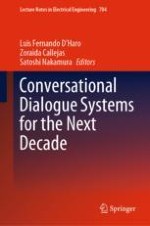2021 | OriginalPaper | Chapter
Authoring Negotiation Content and Programming Simulated Patients
Authors : Volha Petukhova, Firuza Sharifullaeva, Dietrich Klakow
Published in: Conversational Dialogue Systems for the Next Decade
Publisher: Springer Singapore
Activate our intelligent search to find suitable subject content or patents.
Select sections of text to find matching patents with Artificial Intelligence. powered by
Select sections of text to find additional relevant content using AI-assisted search. powered by
